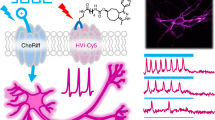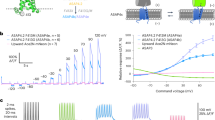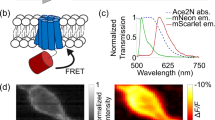Abstract
Reliable optical detection of single action potentials in mammalian neurons has been one of the longest-standing challenges in neuroscience. Here we achieved this goal by using the endogenous fluorescence of a microbial rhodopsin protein, Archaerhodopsin 3 (Arch) from Halorubrum sodomense, expressed in cultured rat hippocampal neurons. This genetically encoded voltage indicator exhibited an approximately tenfold improvement in sensitivity and speed over existing protein-based voltage indicators, with a roughly linear twofold increase in brightness between −150 mV and +150 mV and a sub-millisecond response time. Arch detected single electrically triggered action potentials with an optical signal-to-noise ratio >10. Arch(D95N) lacked endogenous proton pumping and had 50% greater sensitivity than wild type but had a slower response (41 ms). Nonetheless, Arch(D95N) also resolved individual action potentials. Microbial rhodopsin–based voltage indicators promise to enable optical interrogation of complex neural circuits and electrophysiology in systems for which electrode-based techniques are challenging.
This is a preview of subscription content, access via your institution
Access options
Subscribe to this journal
Receive 12 print issues and online access
$259.00 per year
only $21.58 per issue
Buy this article
- Purchase on Springer Link
- Instant access to full article PDF
Prices may be subject to local taxes which are calculated during checkout





Similar content being viewed by others
References
Cohen, L.B., Keynes, R.D. & Hille, B. Light scattering and birefringence changes during nerve activity. Nature 218, 438–441 (1968).
Tasaki, I., Watanabe, A., Sandlin, R. & Carnay, L. Changes in fluorescence, turbidity, and birefringence associated with nerve excitation. Proc. Natl. Acad. Sci. USA 61, 883–888 (1968).
Peterka, D.S., Takahashi, H. & Yuste, R. Imaging voltage in neurons. Neuron 69, 9–21 (2011).
Akemann, W., Mutoh, H., Perron, A., Rossier, J. & Knopfel, T. Imaging brain electric signals with genetically targeted voltage-sensitive fluorescent proteins. Nat. Methods 7, 643–649 (2010).
Scanziani, M. & Hausser, M. Electrophysiology in the age of light. Nature 461, 930–939 (2009).
Homma, R. et al. Wide-field and two-photon imaging of brain activity with voltage-and calcium-sensitive dyes. Philos. Trans. R. Soc. Lond. B Biol. Sci. 364, 2453–2467 (2009).
Jiang, J. & Yuste, R. Second-harmonic generation imaging of membrane potential with photon counting. Microsc. Microanal. 14, 526–531 (2008).
Tsutsui, H., Karasawa, S., Okamura, Y. & Miyawaki, A. Improving membrane voltage measurements using FRET with new fluorescent proteins. Nat. Methods 5, 683–685 (2008).
Siegel, M.S. & Isacoff, E.Y. A genetically encoded optical probe of membrane voltage. Neuron 19, 735–741 (1997).
Sjulson, L. & Miesenbock, G. Rational optimization and imaging in vivo of a genetically encoded optical voltage reporter. J. Neurosci. 28, 5582–5593 (2008).
Bradley, J., Luo, R., Otis, T.S. & DiGregorio, D.A. Submillisecond optical reporting of membrane potential in situ using a neuronal tracer dye. J. Neurosci. 29, 9197–9209 (2009).
Popovic, M.A., Foust, A.J., McCormick, D.A. & Zecevic, D. The spatio-temporal characteristics of action potential initiation in layer 5 pyramidal neurons: a voltage imaging study. J. Physiol. (Lond.) 589, 4167–4187 (2011).
Tian, L. et al. Imaging neural activity in worms, flies and mice with improved GCaMP calcium indicators. Nat. Methods 6, 875–881 (2009).
Kralj, J.M., Hochbaum, D.R., Douglass, A.D. & Cohen, A.E. Electrical spiking in Escherichia coli probed with a fluorescent voltage indicating protein. Science 333, 345–348 (2011).
Ihara, K. et al. Evolution of the archaeal rhodopsins: evolution rate changes by gene duplication and functional differentiation. J. Mol. Biol. 285, 163–174 (1999).
Chow, B.Y. et al. High-performance genetically targetable optical neural silencing by light-driven proton pumps. Nature 463, 98–102 (2010).
Lanyi, J.K. Bacteriorhodopsin. Annu. Rev. Physiol. 66, 665–688 (2004).
Kolodner, P., Lukashev, E.P., Ching, Y. & Rousseau, D.L. Electric-field-induced Schiff-base deprotonation in D85N mutant bacteriorhodopsin. Proc. Natl. Acad. Sci. USA 93, 11618–11621 (1996).
Lenz, M.O. et al. First steps of retinal photoisomerization in proteorhodopsin. Biophys. J. 91, 255–262 (2006).
Shaner, N.C., Steinbach, P.A. & Tsien, R.Y. A guide to choosing fluorescent proteins. Nat. Methods 2, 905–909 (2005).
Mukamel, E.A., Nimmerjahn, A. & Schnitzer, M.J. Automated analysis of cellular signals from large-scale calcium imaging data. Neuron 63, 747–760 (2009).
Borst, A., Heck, D. & Thomann, M. Voltage signals of individual Purkinje cell dendrites in rat cerebellar slices. Neurosci. Lett. 238, 29–32 (1997).
Livet, J. et al. Transgenic strategies for combinatorial expression of fluorescent proteins in the nervous system. Nature 450, 56–62 (2007).
Novikova, L., Novikov, L. & Kellerth, J.O. Persistent neuronal labeling by retrograde fluorescent tracers: a comparison between Fast Blue, Fluoro-Gold and various dextran conjugates. J. Neurosci. Methods 74, 9–15 (1997).
Boyden, E.S., Zhang, F., Bamberg, E., Nagel, G. & Deisseroth, K. Millisecond-timescale, genetically targeted optical control of neural activity. Nat. Neurosci. 8, 1263–1268 (2005).
Tittor, J., Schweiger, U., Oesterhelt, D. & Bamberg, E. Inversion of proton translocation in bacteriorhodopsin mutants D85N, D85T, and D85, 96N. Biophys. J. 67, 1682–1690 (1994).
Obaid, A.L. & Salzberg, B.M. Optical recording of electrical activity in guinea-pig enteric networks using voltage-sensitive dyes. J. Vis. Exp. 34, 1631 (2009).
Venter, J.C. et al. Environmental genome shotgun sequencing of the Sargasso Sea. Science 304, 66–74 (2004).
Fenno, L., Yizhar, O. & Deisseroth, K. The development and application of optogenetics. Annu. Rev. Neurosci. 34, 389–412 (2011).
Rehorek, M. & Heyn, M.P. Binding of all-trans-retinal to the purple membrane. Evidence for cooperativity and determination of the extinction coefficient. Biochemistry 18, 4977–4983 (1979).
Bergo, V., Spudich, E.N., Spudich, J.L. & Rothschild, K.J. Conformational changes detected in a sensory rhodopsin II-transducer complex. J. Biol. Chem. 278, 36556–36562 (2003).
Scharf, B., Hess, B. & Engelhard, M. Chromophore of sensory rhodopsin II from Halobacterium halobium. Biochemistry 31, 12486–12492 (1992).
Oesterhelt, D., Meentzen, M. & Schuhmann, L. Reversible dissociation of the purple complex in bacteriorhodopsin and identification of 13-cis and all-trans-retinal as its chromophores. Eur. J. Biochem. 40, 453–463 (1973).
Vogeley, L. et al. Crystal structure of the Anabaena sensory rhodopsin transducer. J. Mol. Biol. 367, 741–751 (2007).
Acknowledgements
We thank F. Engert (Harvard University) for generously providing support to A.D.D., providing laboratory space during the early stages of this work, and for facilitating this collaboration, E. Boyden (Massachusetts Institute of Technology), K. Rothschild (Boston University) and A. Ting (Massachusetts Institute of Technology) for discussions and contributions of equipment and reagents, and G. Lau, B. Lilley and H. Inada for technical assistance. This work was supported by the Harvard Center for Brain Science, US National Institutes of Health grants 1-R01-EB012498-01 and New Innovator grant 1-DP2-OD007428, the Harvard–Massachusetts Institute of Technology Joint Research Grants Program in Basic Neuroscience, an Intelligence Community postdoctoral fellowship (J.M.K.), a National Science Foundation Graduate Fellowship (D.R.H.), a Helen Hay Whitney Postdoctoral Fellowship (A.D.D.) and Charles A. King Trust Postdoctoral Fellowship (A.D.D.).
Author information
Authors and Affiliations
Contributions
A.E.C. conceived the project. J.M.K., A.D.D. and D.R.H. carried out experiments. D.M. designed and built the imaging system used in Figure 2. All authors designed experiments, analyzed data and wrote the paper.
Corresponding author
Ethics declarations
Competing interests
A.E.C., J.M.K. and A.D.D. filed a patent application (PCT/US11/48793) on microbial rhodopsin–based voltage sensors.
Supplementary information
Supplementary Text and Figures
Supplementary Figures 1–7 and Supplementary Tables 1–2 (PDF 477 kb)
Supplementary Video 1
Fluorescence from an HEK cell expressing Arch. The cell was subjected to steps in voltage from −100 mV to 100 mV at 1 Hz. The apparent voltage-sensitive pixels inside the cell are due to out-of-focus fluorescence from the upper and lower surfaces of the plasma membrane. Images are unmodified raw data. Movie is shown in real time. (AVI 663 kb)
Supplementary Video 2
Fluorescence from a rat hippocampal neuron expressing Arch, showing single-trial detection of action potentials. The field on the left shows the time-averaged fluorescence; the field on the right shows deviations from the time average. Movie has been slowed 25-fold. (AVI 5866 kb)
Supplementary Video 3
Fluorescence from a rat hippocampal neuron expressing Arch, averaged over n = 98 action potentials. Note the delayed rise and fall of the action potential in the small protrusion coming from the process at 7 o'clock relative to the cell body. The time-averaged fluorescence from the cell has been subtracted to highlight the change in fluorescence during an action potential. The background, in gray, shows the time-averaged image. (AVI 695 kb)
Supplementary Video 4
Fluorescence from a HEK cell expressing Arch(D95N) subjected to steps in voltage from −100 mV to 100 mV at 1 Hz. The apparent voltage-sensitive pixels inside the cell are due to out-of-focus fluorescence from the upper and lower surfaces of the plasma membrane. Images are unmodified raw data. Movie is shown in real time. (AVI 2009 kb)
Supplementary Video 5
Fluorescence from a HEK cell expressing Arch(D95N) subjected to a voltage-clamp triangle wave from −150 mV to 150 mV. The apparent voltage-sensitive pixels inside the cell are due to out-of-focus fluorescence from the upper and lower surfaces of the plasma membrane. The movie is sped up threefold. Images are unmodified raw data. (AVI 1110 kb)
Supplementary Software
extractV.m and ApplyWeights.m Matlab routines for analyzing voltage indicator image data. (ZIP 4 kb)
Rights and permissions
About this article
Cite this article
Kralj, J., Douglass, A., Hochbaum, D. et al. Optical recording of action potentials in mammalian neurons using a microbial rhodopsin. Nat Methods 9, 90–95 (2012). https://doi.org/10.1038/nmeth.1782
Received:
Accepted:
Published:
Issue Date:
DOI: https://doi.org/10.1038/nmeth.1782
This article is cited by
-
Widefield imaging of rapid pan-cortical voltage dynamics with an indicator evolved for one-photon microscopy
Nature Communications (2023)
-
Voltage-Seq: all-optical postsynaptic connectome-guided single-cell transcriptomics
Nature Methods (2023)
-
All-optical closed-loop voltage clamp for precise control of muscles and neurons in live animals
Nature Communications (2023)
-
On the fluorescence enhancement of arch neuronal optogenetic reporters
Nature Communications (2022)
-
Aion is a bistable anion-conducting channelrhodopsin that provides temporally extended and reversible neuronal silencing
Communications Biology (2022)



